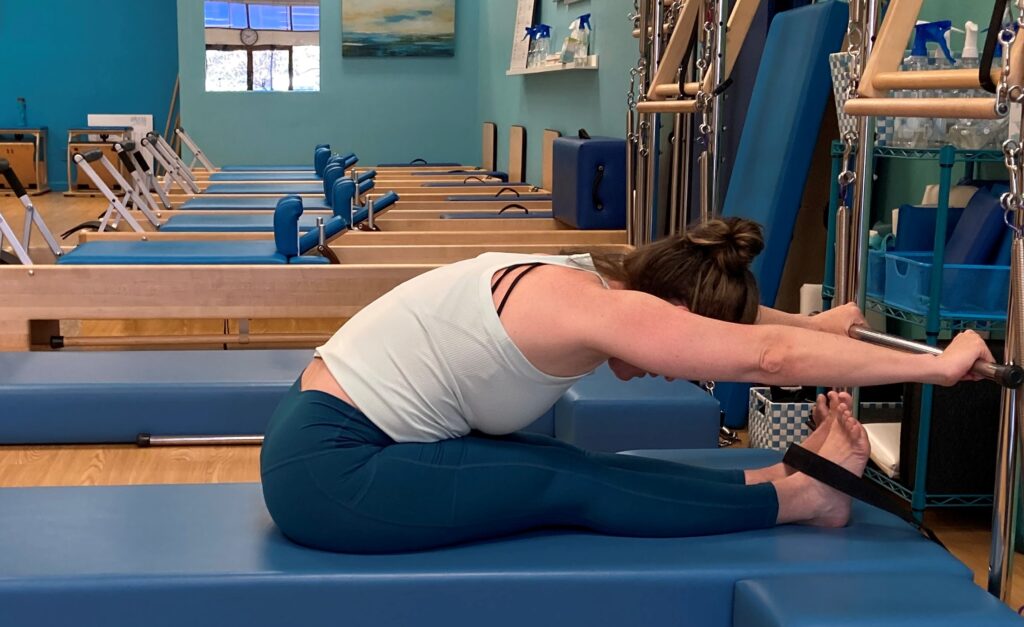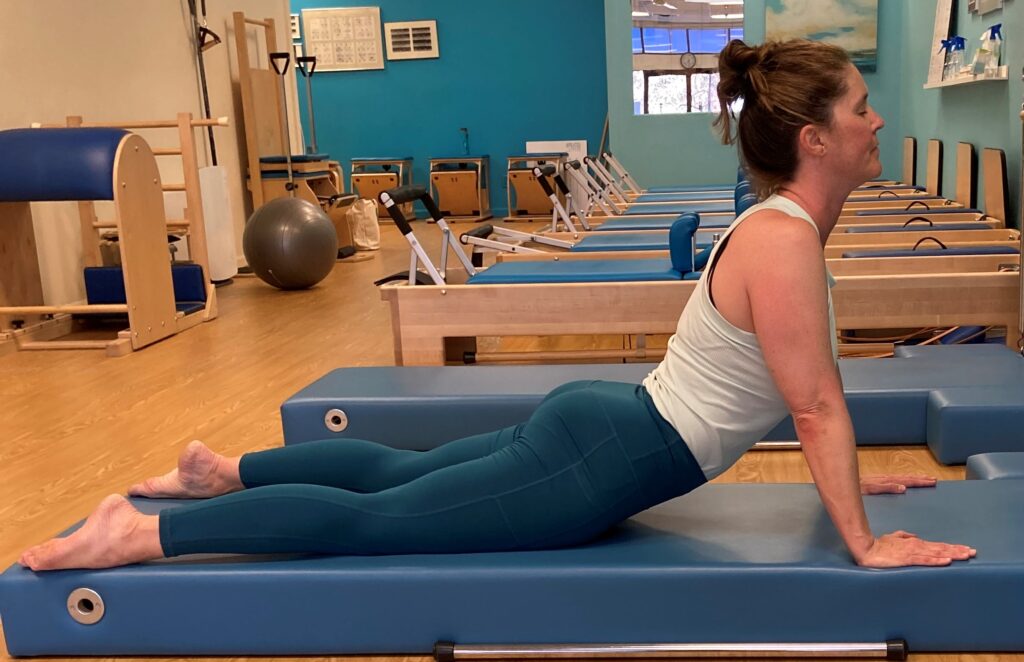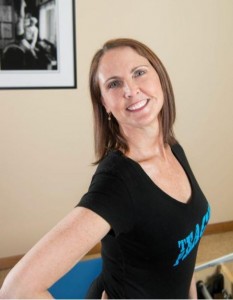Issue #402 – Wednesday, May 31, 2023
“π”-lates: How to Know if a Pilates Movement is Right
by Amy Alpers
Do you ever wonder if you are teaching a Pilates movement or exercise correctly – like how should the spine flex in Roll Up, for instance, or in Stomach Massage, or how do you describe the Pilates “curl” in the 100? Or if you are facilitating healthy, wise, safe spinal extension in the Swan, or Pull Straps/T, Breaststroke, Back Head Stand? Or, when teaching exercises such as Saw or Corkscrew or Twist, do you feel confident in how you’re explaining spinal rotation? How does one know anyway? Who’s to say who’s right or wrong? There are as many opinions and beliefs about these exercises and movement skills as there are Pilates teachers.
So, how do we decide? How do we know the true answer? I thought about this question for many, many years. How do I truly feel confident that I’m asking for the correct, healthiest movement when there are so many differing opinions on how to teach a Pilates exercise correctly? Students and clients would actually ask me that very question. Then I realized I’d known my answer for a long time. My answer is simple – nature. Nature has all the answers to how human movement is designed to work. And nature reveals itself to us in numbers.
“The book of nature is written in the language of mathematics.”Galileo Galilei
Consider Pi (“π” = 3.14159….). Pi is a mathematical constant encoded in most processes occurring in the universe. Pi can be found in the rainbow, in the moon, in the sun, and even in a falling raindrop or an orbiting planet. Pi is used to construct arches, bridges, churches, and buildings. We can also find this essential quantity in humans – in the sound of a pulsing heart, in the timing of cell division, in the double helix of DNA, in the pupil of the eye, in the breathing cycle, and in the circadian rhythms controlling sleep-wake cycles. So Pi is encoded in the patterns of human movement. And if we look at human movement through this lens and try to see the true nature of its design, it begins to reveal itself beautifully.
“Look deep into nature and you will understand everything better.” Albert Einstein.
Watch cats pandiculate, fish school, birds murmurate, rivers meander, waves crest, trees branch out, grasses grow, flowers bloom, ferns curl – you will see the natural patterns of movements. It’s these that will help you to determine if and when a human is also moving naturally, versus mechanically or artificially or incorrectly.
There is also another mathematical code that reveals the true nature of movement – the Fibonacci Sequence or the Golden Ratio. The Fibonacci sequence is a series of numbers in which each number is the sum of the two that precede it. It looks like this: 0, 1, 1, 2, 3, 5, 8, 13, 21, 34, and so on, forever. In other words – 0+1=1; 1+1=2; 1+2=3; 2+3=5; etc. This mathematical code determines the inherent spiral pattern such as in a galaxy, or a fern, a nautilus shell, or an ocean wave. Or a human spine.
Let’s consider the forward flexion of the spine in various Pilates exercises.
Roll-Up: Joe Pilates declared that we should all be able to simply lie on our backs and roll up, one vertebra at a time, and put our heads on our knees! Sounds so simple, right? Anyone who’s struggled with this exercise in Pilates knows it’s not simple at all. Our spines are struggling these days. 21st Century living is not good to our spines in any way. So how do you, as the teacher, know if you’re even saying the right things to help those struggling spines flex? Do you feel confident that you are able to truly understand when and where the movement first goes wrong?
Just watch the spine bend like you’re watching a fern curl, or a seahorse tail twirl, or a nautilus shell spiral, or an ocean wave rise. When you blur your vision and impose nature’s true design, you can learn to see it very quickly – where it’s correct and also where and when it goes wrong. It will be revealed instantly through your intuitive understanding as that grows by watching nature do it perfectly again and again.


“Nature is the source of all true knowledge.” Leonardo Da Vinci
How many other Pilates exercises use that same exact spinal flexion pattern? Think Roll-Over, Short Spine, Spine Stretch, Jackknife, Snake, Tendon Stretch, Stomach Massage. How many more can you think of? The spine should always flex this same way – no matter what exercise you’re doing, on whatever piece of equipment you’re on, or at whatever level. All forward spinal flexion exercises require the same sequence because that’s how nature works. Once you’ve seen it and taught it the way nature designed it, it’s the only way you’ll ever want to teach it.
It’s the same sequential pattern in spinal extension as well, even though the vertebrae have different boney shapes and articulations in the reverse direction. Still, the task remains the same – to see the sequential pattern of the curling fern, wave, nautilus shell, or galaxy spiral, as each joint extends. I use the image of a Ferris Wheel to help people understand it better. A Ferris Wheel, just like a spine, must utilize the physics of nature to work correctly. If you imagine that the vertebra you are just about to extend “backwards” is more like the car in front of you on a Ferris wheel, you can understand that the vertebra you’re moving must go down and forward first, before it goes backward. If each vertebra follows this truth, just as that car on the Ferris wheel will end up going around the circle and end up behind, so will your spine.


“The wisest and noblest teacher is nature itself.” Leonardo Da Vinci

Amy Taylor Alpers co-founded The Pilates Center (TPC) and The Pilates Center Teacher Training Program (TPCTTP) over 20 years ago in Boulder, Colorado. When not traveling the world to teach both foundational and graduate level Pilates teacher education she remains part of the core faculty for TPCTTP, mentors advanced teachers, teaches classes and sees clients. In addition to teaching TPC sponsored workshops, Amy has presented numerous times at the Pilates Method Alliance Annual Meeting, Balanced Body’s Pilates on Tour and Passing the Torch. In 2013, Amy presented at the Shared Traditions Conference for Fletcher Pilates and will present at The Pilates Roundtable.
Amy was born in Youngstown, Ohio where she began classical ballet at age two.
She attended The Juilliard School for Dance, danced with the Garden State Ballet in New Jersey, and received a B.A. in Dance and a M.A. in Dance History from New York University. In addition, Amy taught ballet at various dance schools in New York City for ten years before launching her Pilates career.
Both Amy and her sister Rachel studied Pilates under the direct tutelage of Romana Kryzanowska at the original Pilates Studio in New York City. They received their Pilates teaching certificate from there in July of 1989. In 1990, after moving to Boulder, Colorado, Amy and Rachel founded The Pilates Center. The sisters then created and established The Pilates Center Teacher Training Program in 1991. The school has since expanded to include an Intermediate Program, Advanced Program, Bridge Program, Master’s Program, and a Mentorship Program. In addition, TPC now has “Licensed” and “Host” studios established all around the world.
Amy and her sister wrote The Everything Pilates Book, published in 2002. She was a founding board member of the PMA and sat on the board that created the PMA Certification Exam. Recently she has also had the honor of filming classes and workshops for online organizations such as Pilates Anytime and Pilates On Demand.
In 2011, Amy, her sister Rachel, and Ken Endelman of Balanced Body, developed CenterLine – a line of equipment designed for classical Pilates and based upon the specifications pioneered by Joseph Pilates.

